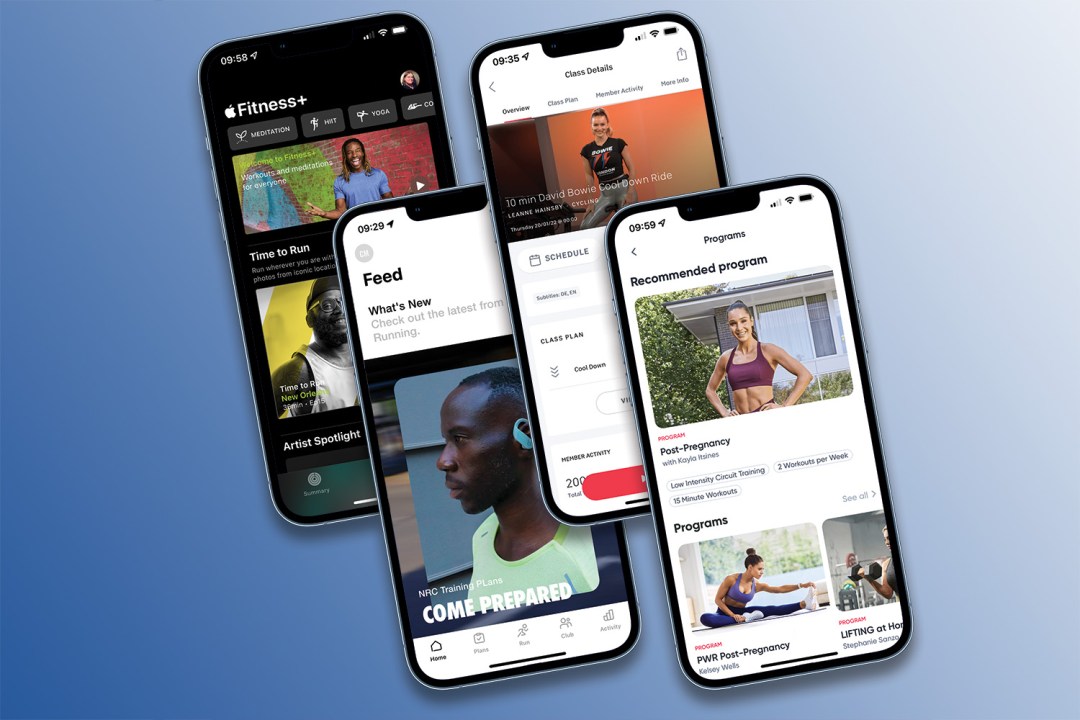Best fitness services: Apple Fitness+ vs Peloton vs Nike Run Club vs Sweat
Today’s fitness services can motivate you and monitor your progress, showing you how to work out effectively and safely

We’ve come a long way since the days of VHS aerobics videos. Now you can install an app that’s a personal trainer right there on your phone, your watch or your smart TV. Today’s fitness services can motivate you and monitor your progress, showing you how to work out effectively and safely, and they cover every possible kind of activity. Some go even further, including dance-inspired workouts as well as specifically tailored workouts – for example, those for post-pregnancy or safe and steady recovery from sports injuries.
Choosing the right fitness service for you
Choosing the right app comes down to two questions: what would you like to do, and what hardware would you like to do it on? That hardware isn’t gym equipment – it’s the smartphone you have, plus accessories such as smartwatches and smart TVs. For example, the Peloton app works on a range of TV platforms including Amazon’s Fire Stick and also has a smartwatch app; and Apple’s Fitness+ does really clever things if you have an Apple Watch and Apple TV as well as an iPhone.
Below we’ve considered four leading fitness services. While they’re all suitable for beginners plus intermediate and expert users, they are focused on different needs. For runners, there’s the brilliant Nike Run Club, which delivers tons of great features free of charge. For women and non-binary people, there’s Sweat, which offers more than just traditional workouts. And for all-around exercise, we’ve got Apple Fitness+ and Peloton, both of which offer highly polished experiences with excellent soundtracks and a wide range of activities.
They’re all very good for users of all levels… and much cheaper than a gym membership. But there are some important differences between them in terms of the workouts they offer and the platforms they work on – what’s perfect for you might not be ideal for someone whose goals are a little bit different.
Apple Fitness+
If you’re an Apple user, you’ll love Fitness+. It integrates tightly with your iPhone, your Apple Watch and your Apple TV to deliver genuinely personalised workouts and coaching across every conceivable activity: not just traditional workouts and runs but also HIIT, yoga and dancing. It’s £9.99/m for up to six users in one household (everybody gets their own version so your family won’t mess up your stats), and the audio and video guides are very high-quality. If you’re all-in on Apple, it tracks all kinds of things – including walking the dog and mooching around the shops – and it works seamlessly with Apple’s Health app.
Nike Run Club
Nike Run Club is all about motivation. It uses gamification – with video game-style encouragement and rewards – and friendly challenges to keep you pounding the pavements, and it’s very good at congratulating you on little wins as well as big milestones. You can share your achievements, which turns out to be a very effective way of getting you off the sofa and into your running shoes. It’s a polished, beautifully designed app with excellent visuals and good music integration, and it’s ad-supported so you don’t have to pay a penny. This is a superb option for urban and rural running.
Peloton
Peloton might be known for its extremely expensive stationary bikes, but you don’t need a Peloton bike to use the app – and it’s not just about cycling either. Its video guides cover a wide range of fitness activities including cycling, strength training and running but also boxing, yoga and Pilates. Classes are both live and on-demand so you can use them at times that suit you, and there’s a particularly good collection of guides covering recovery and mobility. In addition to phone and tablet apps, Peloton also works on multiple TV platforms including Apple, Google, Roku and Amazon. The price is surprisingly low too: £12.99/m.
Sweat
Sweat was designed for women and non-binary people; and while it covers all the key workout types, there are also programmes you won’t find in many apps – such as post-pregnancy fitness and workouts based on barre, which is a low-impact exercise technique that combines elements of ballet, yoga and Pilates. One of Sweat’s key selling points is that you can use it anywhere, even if you don’t have any equipment to hand: it’s packed with workouts that’ll really push your body no matter where you happen to be, and the superb Apple Watch app means you don’t need to have your phone handy. It’s £14.99/m.
Does it matter if you have Android or iOS?
You’ll find a broad selection of fitness apps in both Apple’s App Store and the Google Play Store, but there are omissions – most notably Apple Fitness+, which is not on Android. Most mainstream apps are multi-platform, though. While smartphone apps can import and use data from all kinds of sources, including smartwatches, there’s no Android / Google Wear equivalent of the tight integration between Fitness+ and Apple Watch.
Both Apple and Google offer family sharing of apps. Fitness+ shares automatically, so up to five other family members can use it with their own tracking and workouts, but most other fitness apps are only for single-person use. If you want to stream your workouts to the TV, Apple offers the best integration. It combines Apple TV, Apple Fitness+ and your Apple Watch to deliver a personalised big-screen workout.